Top Rankings
Rich School District ranks among the top 20% of public school district in Utah for:
Category
Attribute
Overall Rank
Highest overall rank (Top 20%)
Math Proficiency
Highest math proficiency (Top 20%)
Reading/Language Arts Proficiency
Highest reading/language arts proficiency (Top 20%)
Science Proficiency
Highest science proficiency (Top 10%)
Student Attention
Lowest student:teacher ratio (Top 1%)
For the 2025 school year, there is 1 public preschool serving 8 students in Rich School District.
Public Preschools in Rich School District have a diversity score of 0.00, which is less than the Utah public preschool average of 0.48.
Minority enrollment is 0% of the student body (majority Black and Hispanic), which is less than the Utah public preschool average of 31% (majority Hispanic).
Overview
This School District
This State (UT)
# Schools
5 Schools
408 Schools
# Students
531 Students
195,137 Students
# Teachers
31 Teachers
9,057 Teachers
Student : Teacher Ratio
17:1
17:1
District Rank
Rich School District, which is ranked within the top 20% of all 153 school districts in Utah (based off of combined math and reading proficiency testing data) for the 2020-2021 school year.
The school district's graduation rate of 90% has stayed relatively flat over five school years.
Overall District Rank
#21 out of 154 school districts
(Top 20%)
(Top 20%)
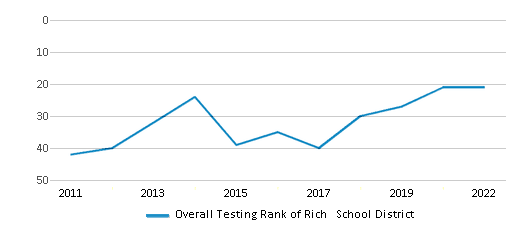
Math Test Scores (% Proficient)
(20-21)51%
39%
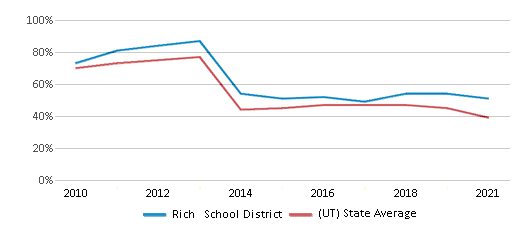
Reading/Language Arts Test Scores (% Proficient)
(20-21)55%
43%
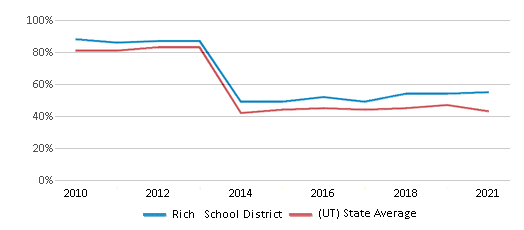
Science Test Scores (% Proficient)
(20-21)60%
45%
Graduation Rate
≥90%
88%
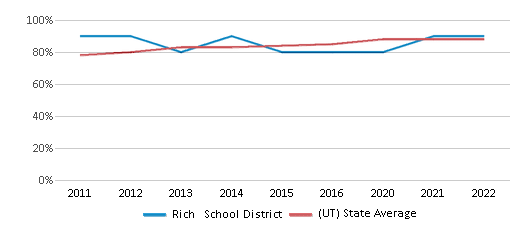
Students by Ethnicity:
Diversity Score
0.13
0.48
# American Indian Students
n/a
2,004 Students
% American Indian Students
n/a
1%
# Asian Students
n/a
2,792 Students
% Asian Students
n/a
2%
# Hispanic Students
23 Students
41,494 Students
% Hispanic Students
4%
21%
# Black Students
n/a
2,695 Students
% Black Students
n/a
1%
# White Students
496 Students
134,941 Students
% White Students
93%
69%
# Hawaiian Students
3 Students
3,551 Students
% Hawaiian Students
1%
2%
# Two or more races Students
9 Students
7,647 Students
% of Two or more races Students
2%
4%
Students by Grade:
# Students in PK Grade:
8
16,151
# Students in K Grade:
30
23,940
# Students in 1st Grade:
42
24,978
# Students in 2nd Grade:
40
26,403
# Students in 3rd Grade:
46
26,290
# Students in 4th Grade:
40
26,559
# Students in 5th Grade:
31
27,209
# Students in 6th Grade:
43
18,075
# Students in 7th Grade:
41
1,029
# Students in 8th Grade:
43
1,462
# Students in 9th Grade:
42
1,079
# Students in 10th Grade:
39
570
# Students in 11th Grade:
42
560
# Students in 12th Grade:
44
832
# Ungraded Students:
-
-
District Revenue and Spending
The revenue/student of $21,006 is higher than the state median of $10,732. The school district revenue/student has declined by 7% over four school years.
The school district's spending/student of $21,122 is higher than the state median of $10,829. The school district spending/student has declined by 7% over four school years.
Total Revenue
$11 MM
$7,309 MM
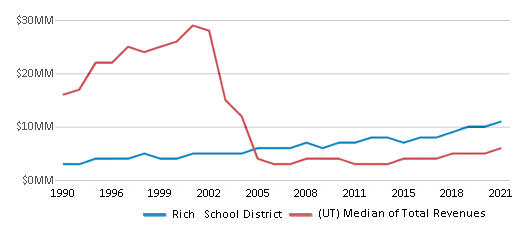
Spending
$11 MM
$7,375 MM

Revenue / Student
$21,006
$10,732
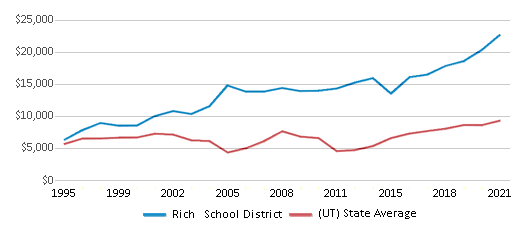
Spending / Student
$21,122
$10,829
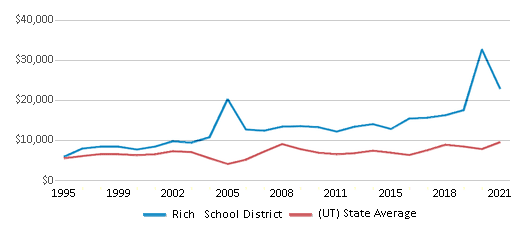
Best Rich School District Public Preschools (2025)
School
(Math and Reading Proficiency)
(Math and Reading Proficiency)
Location
Grades
Students
Rank: n/an/a
Rich Preschool
Special Education School
25 South 100w, 25 S 100 W
Randolph, UT 84064
(435) 793-2135
Randolph, UT 84064
(435) 793-2135
Grades: PK
| 8 students
Recent Articles

What Is A Charter School?
Explore the world of charter schools in this comprehensive guide. Learn about their history, how they operate, and the pros and cons of this educational innovation. Discover key facts about charter schools, including admission policies, demographics, and funding, as well as what to look for when considering a charter school for your child.

10 Reasons Why High School Sports Benefit Students
Discover the 10 compelling reasons why high school sports are beneficial for students. This comprehensive article explores how athletics enhance academic performance, foster personal growth, and develop crucial life skills. From improved fitness and time management to leadership development and community representation, learn why participating in high school sports can be a game-changer for students' overall success and well-being.

February 05, 2025
Understanding the U.S. Department of Education: Structure, Impact, and EvolutionWe explore how the Department of Education shapes American education, from its cabinet-level leadership to its impact on millions of students, written for general audiences seeking clarity on this vital institution.





